Coupling of the AQUATOX and EFDC Models for Ecological Impact Assessment of Chemical Spill Scenarios in the Jeonju River, Korea
Simple Summary
Abstract
1. Introduction
2. Materials and Methods
2.1. Concept of AQUATOX-EDFC Model
2.2. Characteristics of Study Area
2.3. Species Matching and Food Web
2.4. Biomass Density of Species
2.5. EFDC Modeling for Flow Rate of Each Segment
2.6. AQUATOX-EFDC Coupling
2.7. Simulation of Control and Perturbed Scenario
2.8. Calculation of Relative Biomass and Impact Indicators
3. Results and Discussion
3.1. Toluene Concentration after Spill Accident in Jeonju River
3.2. Total Biomass Changes of Organisms in the Jeonju River
3.3. Biomass Changes of Single Species
3.4. Relationship between Biomass Changes and LC50 of Organisms
3.5. Impact of Toluene Spill on Ecological Structure
4. Conclusions
Supplementary Materials
Author Contributions
Funding
Conflicts of Interest
References
- Khan, F.I.; Abbasi, S. Major accidents in process industries and an analysis of causes and consequences. J. Loss Prev. Process. Ind. 1999, 12, 361–378. [Google Scholar] [CrossRef]
- OECD. OECD Environmental Outlook for the Chemicals Industry 2001. Available online: https://www.oecd.org/env/ehs/2375538.pdf (accessed on 1 September 2019).
- Broughton, E. The Bhopal disaster and its aftermath: A review. Environ. Health 2005, 4, 6. [Google Scholar] [CrossRef]
- Fatemi, F.; Ardalan, A.; Mansouri, N.; Aguirre, B.; Mohammdfam, I. Industrial chemical accidents: A growing health hazard in the Islamic Republic of Iran. East. Mediterr. Heal. J. 2019, 25, 5–11. [Google Scholar] [CrossRef]
- Madejón, P.; Domínguez, M.T.; Madejón, E.; Cabrera, F.; Marañón, T.; Murillo, J. Soil-plant relationships and contamination by trace elements: A review of twenty years of experimentation and monitoring after the Aznalcóllar (SW Spain) mine accident. Sci. Total. Environ. 2018, 625, 50–63. [Google Scholar] [CrossRef]
- Integrated Chemical Substance Information System. Available online: https://icis.me.go.kr/main.do (accessed on 5 August 2020).
- Lee, H.-J.; Kim, H.-J.; Yoo, S.-H. The Public Willingness to Pay for Reducing the Incidence of Hazardous Chemical Spill Accidents by Half in South Korea. Sustainability 2018, 10, 2673. [Google Scholar] [CrossRef]
- Anjum, H.; Johari, K.; Gnanasundaram, N.; Ganesapillai, M.; Arunagiri, A.; Regupathi, I.; Thanabalan, M. A review on adsorptive removal of oil pollutants (BTEX) from wastewater using carbon nanotubes. J. Mol. Liq. 2019, 277, 1005–1025. [Google Scholar] [CrossRef]
- Herman, D.C.; Inniss, W.E.; Mayfield, C.I. Impact of volatile aromatic hydrocarbons, alone and in combination, on growth of the freshwater alga Selenastrum capricornutum. Aquat. Toxicol. 1990, 18, 87–100. [Google Scholar] [CrossRef]
- Peng, C.; Lee, J.-W.; Sichani, H.T.; Ng, J.C. Toxic effects of individual and combined effects of BTEX on Euglena gracilis. J. Hazard. Mater. 2015, 284, 10–18. [Google Scholar] [CrossRef] [PubMed]
- Aruoja, V.; Moosus, M.; Kahru, A.; Sihtmäe, M.; Maran, U. Measurement of baseline toxicity and QSAR analysis of 50 non-polar and 58 polar narcotic chemicals for the alga Pseudokirchneriella subcapitata. Chemosphere 2014, 96, 23–32. [Google Scholar] [CrossRef] [PubMed]
- Li, X.; Zhou, Q.; Luo, Y.; Yang, G.; Zhou, T. Joint action and lethal levels of toluene, ethylbenzene, and xylene on midge (Chironomus plumosus) larvae. Environ. Sci. Pollut. Res. 2012, 20, 957–966. [Google Scholar] [CrossRef]
- Zhang, L.; Cui, J.; Song, T.; Liu, Y. Application of an AQUATOX model for direct toxic effects and indirect ecological effects assessment of Polycyclic aromatic hydrocarbons (PAHs) in a plateau eutrophication lake, China. Ecol. Model. 2018, 388, 31–44. [Google Scholar] [CrossRef]
- Ahmadi-Mamaqani, Y.; Khorasani, N.; Talebi, K.; Hashemi, S.H.; Rafiee, G.; Bahadori-Khosroshahi, F. Diazinon Fate and Toxicity in the Tajan River (Iran) Ecosystem. Environ. Eng. Sci. 2011, 28, 859–868. [Google Scholar] [CrossRef]
- Lei, B.; Huang, S.; Qiao, M.; Li, T.; Wang, Z. Prediction of the environmental fate and aquatic ecological impact of nitrobenzene in the Songhua River using the modified AQUATOX model. J. Environ. Sci. 2008, 20, 769–777. [Google Scholar] [CrossRef]
- Scholz-Starke, B.; Ottermanns, R.; Rings, U.; Floehr, T.; Hollert, H.; Hou, J.; Li, B.; Wu, L.L.; Yuan, X.; Strauch, K.; et al. An integrated approach to model the biomagnification of organic pollutants in aquatic food webs of the Yangtze Three Gorges Reservoir ecosystem using adapted pollution scenarios. Environ. Sci. Pollut. Res. 2013, 20, 7009–7026. [Google Scholar] [CrossRef]
- Zhang, L.; Liu, J. AQUATOX coupled foodweb model for ecosystem risk assessment of Polybrominated diphenyl ethers (PBDEs) in lake ecosystems. Environ. Pollut. 2014, 191, 80–92. [Google Scholar] [CrossRef]
- Galic, N.; Salice, C.J.; Birnir, B.; Bruins, R.J.; Ducrot, V.; Jager, H.I.; Kanarek, A.; Pastorok, R.; Rebarber, R.; Thorbek, P.; et al. Predicting impacts of chemicals from organisms to ecosystem service delivery: A case study of insecticide impacts on a freshwater lake. Sci. Total. Environ. 2019, 682, 426–436. [Google Scholar] [CrossRef] [PubMed]
- Tetra Tech, Inc. The Environmental Fluid Dynamics Code Theory and Computation. Volume 1: Hydrodynamics and Mass Transport; Tetra Tech, Inc.: Fairfax, VA, USA, 2007. [Google Scholar]
- Park, R.A.; Clough, J.S.; Wellman, M.C. AQUATOX: Modeling environmental fate and ecological effects in aquatic ecosystems. Ecol. Model. 2008, 213, 1–15. [Google Scholar] [CrossRef]
- Lombardo, A.; Franco, A.; Pivato, A.; Barausse, A. Food web modeling of a river ecosystem for risk assessment of down-the-drain chemicals: A case study with AQUATOX. Sci. Total. Environ. 2015, 508, 214–227. [Google Scholar] [CrossRef]
- Froese, R. Cube law, condition factor and weight-length relationships: History, meta-analysis and recommendations. J. Appl. Ichthyol. 2006, 22, 241–253. [Google Scholar] [CrossRef]
- Basset, A. Resource-mediated effects of stream pollution on food absorption of Asellus aquaticus (L.) populations. Oecologia 1993, 93, 315–321. [Google Scholar] [CrossRef]
- Benke, A.C.; Huryn, A.D.; Smock, L.A.; Wallace, J.B. Length-Mass Relationships for Freshwater Macroinvertebrates in North America with Particular Reference to the Southeastern United States. J. N. Am. Benthol. Soc. 1999, 18, 308–343. [Google Scholar] [CrossRef]
- Giustini, M.; Miccoli, F.P.; De Luca, G.; Cicolani, B. Length–weight relationships for some plecoptera and ephemeroptera from a carbonate stream in central Apennine (Italy). Hydrobiologia 2008, 605, 183–191. [Google Scholar] [CrossRef]
- Johnston, T.A.; Cunjak, R.A. Dry mass-length relationships for benthic insects: A review with new data from Catamaran Brook, New Brunswick, Canada. Freshw. Biol. 1999, 41, 653–674. [Google Scholar] [CrossRef]
- Miyasaka, H.; Genkai-Kato, M.; Miyake, Y.; Kishi, D.; Katano, I.; Doi, H.; Ohba, S.-Y.; Kuhara, N. Relationships between length and weight of freshwater macroinvertebrates in Japan. Limnology 2008, 9, 75–80. [Google Scholar] [CrossRef]
- Nakagawa, H.; Takemon, Y. Length-mass relationships of macro-invertebrates in a freshwater stream in Japan. Aquat. Insects 2014, 36, 53–61. [Google Scholar] [CrossRef]
- Rogers, L.E.; Hinds, W.T.; Buschbom, R.L. A General Weight vs. Length Relationship for Insects1. Ann. Èntomol. Soc. Am. 1976, 69, 387–389. [Google Scholar] [CrossRef]
- Miserendino, M.L. Length -mass relationships for macroinvertebrates in freshwater environments of Patagonia (Argentina). Ecol. Austral 2001, 11, 3–8. [Google Scholar] [CrossRef]
- Uhm, S.-H. Study on the Grazing Relationship and Energy Transfer between Zooplankton and Phytoplankton and Bacteria in Lake Paldang Ecosystem. Master’s Thesis, Konkuk University, Seoul, Korea, 2007. [Google Scholar]
- Yoon, C.G.; Rhee, H.-P.; Son, Y. Applicability study of ecological impact assessment using AQUATOX model in Paldang Reservoir, South Korea. DESALINATION Water Treat. 2017, 60, 39–47. [Google Scholar] [CrossRef]
- Clough, J.S. AQUATOX (Release 3.1 plus): Modeling Environmental Fate and Ecological Effects in Aquatic Ecosystems Volume 2: Technical Documentation; United States Environmental Protection Agency: Washington, DC, USA, 2014.
- Clough, J.S. AQUATOX (Release 3.1): Modeling Environmental Fate and Ecological Effects in Aquatic Ecosystems Volume 1: User’s Manual; United States Environmental Protection Agency: Washington, DC, USA, 2012.
- Parvez, S.; Venkataraman, C.; Mukherji, S. Toxicity assessment of organic pollutants: Reliability of bioluminescence inhibition assay and univariate QSAR models using freshly prepared Vibrio fischeri. Toxicol. Vitr. 2008, 22, 1806–1813. [Google Scholar] [CrossRef]
- Grechi, L.; Franco, A.; Palmeri, L.; Pivato, A.; Barausse, A. An ecosystem model of the lower Po river for use in ecological risk assessment of xenobiotics. Ecol. Model. 2016, 332, 42–58. [Google Scholar] [CrossRef]
- McCay, D.F.; Isaji, T. Evaluation of the consequences of chemical spills using modeling: Chemicals used in deepwater oil and gas operations. Environ. Model. Softw. 2004, 19, 629–644. [Google Scholar] [CrossRef]
- Gros, J.; Nabi, D.; Würz, B.; Wick, L.Y.; Brussaard, C.P.D.; Huisman, J.; Van Der Meer, J.R.; Reddy, C.M.; Arey, J.S. First Day of an Oil Spill on the Open Sea: Early Mass Transfers of Hydrocarbons to Air and Water. Environ. Sci. Technol. 2014, 48, 9400–9411. [Google Scholar] [CrossRef] [PubMed]
- Hibbs, D.E.; Gulliver, J.S.; Voller, V.R.; Chen, Y.-F. An aqueous concentration model for riverine spills. J. Hazard. Mater. 1999, 64, 37–53. [Google Scholar] [CrossRef]
- Choi, W.; Ahn, I. Predator-prey interaction systems with non-uniform dispersal in a spatially heterogeneous environment. J. Math. Anal. Appl. 2020, 485, 123860. [Google Scholar] [CrossRef]
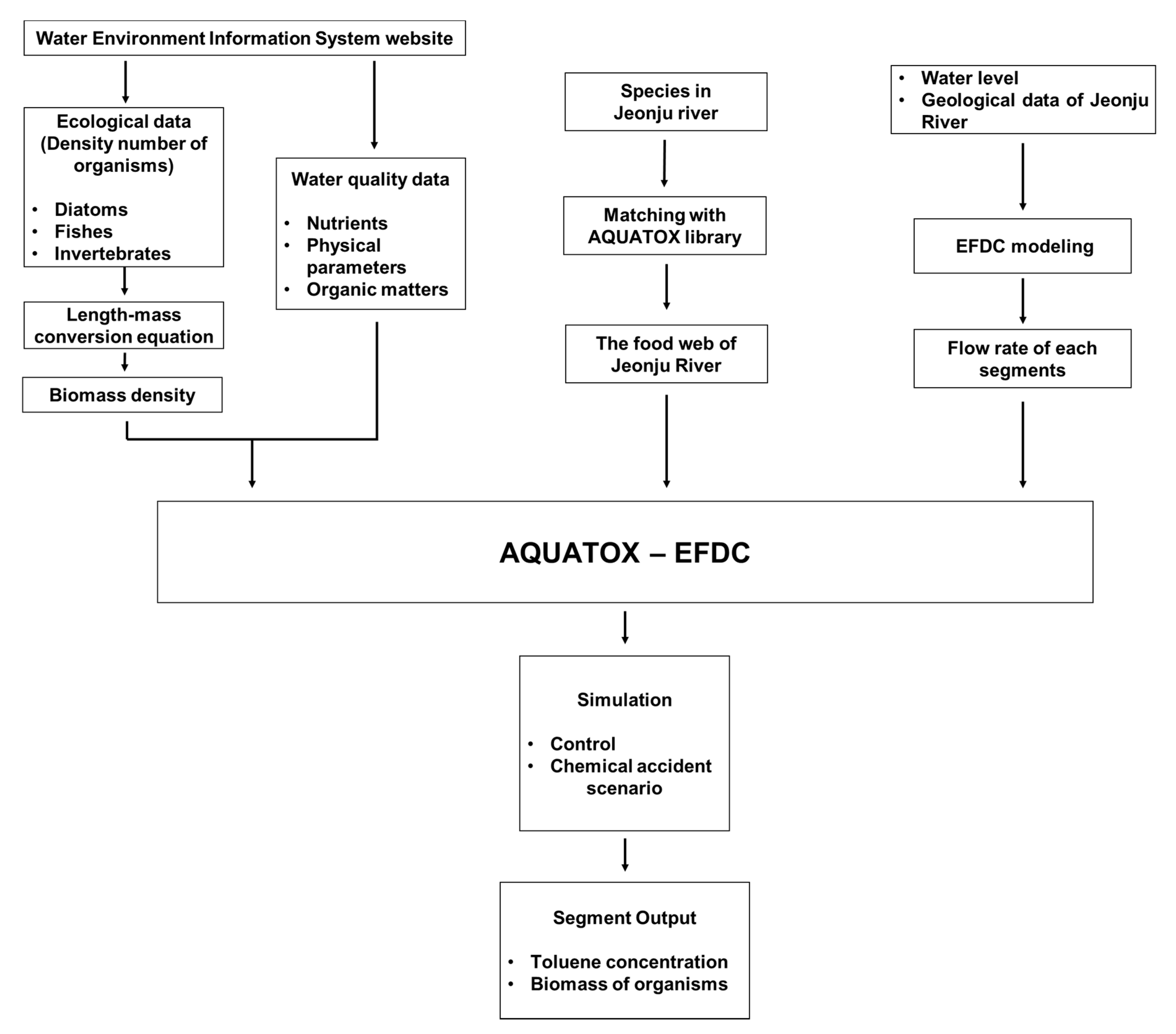
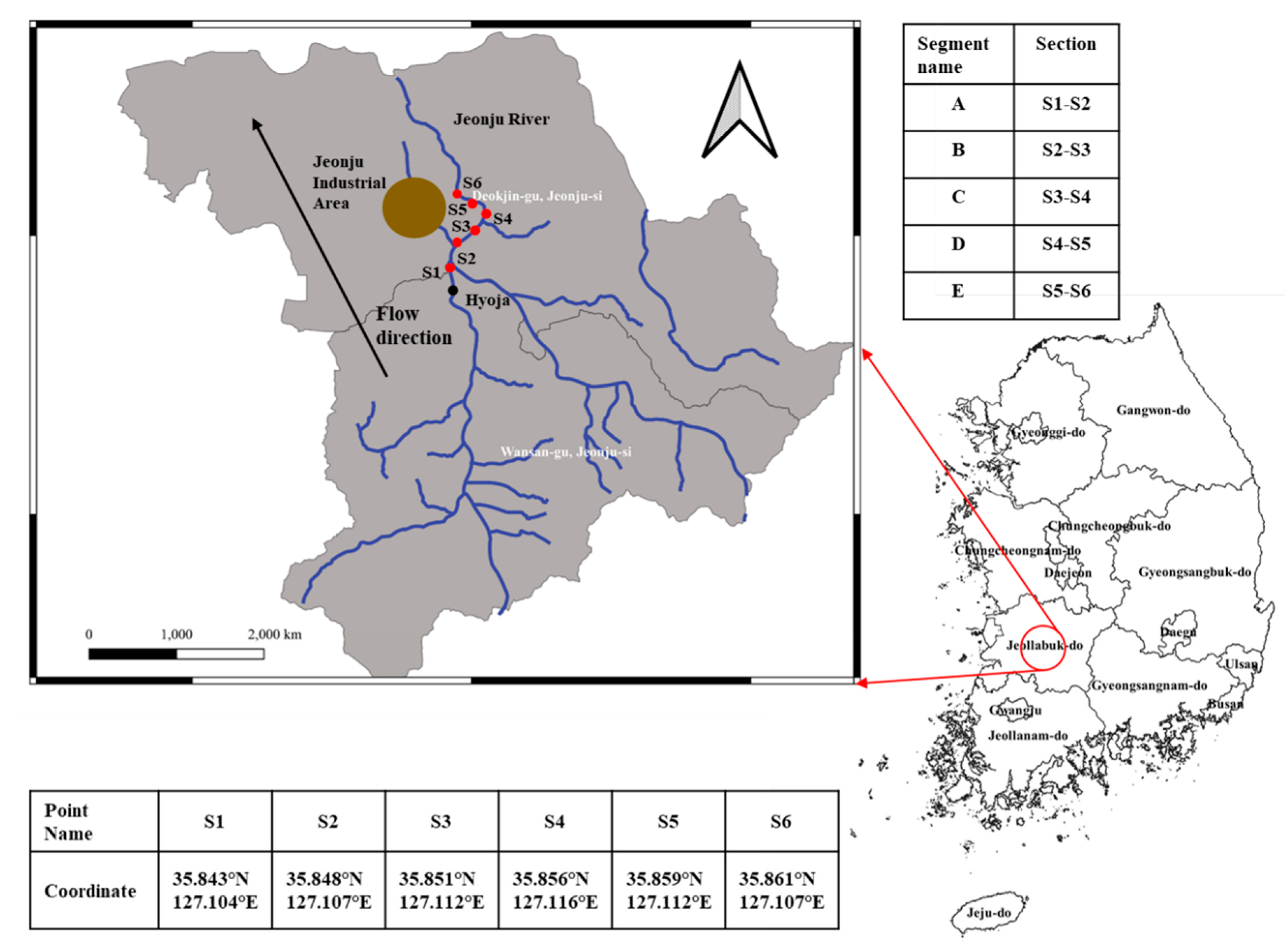
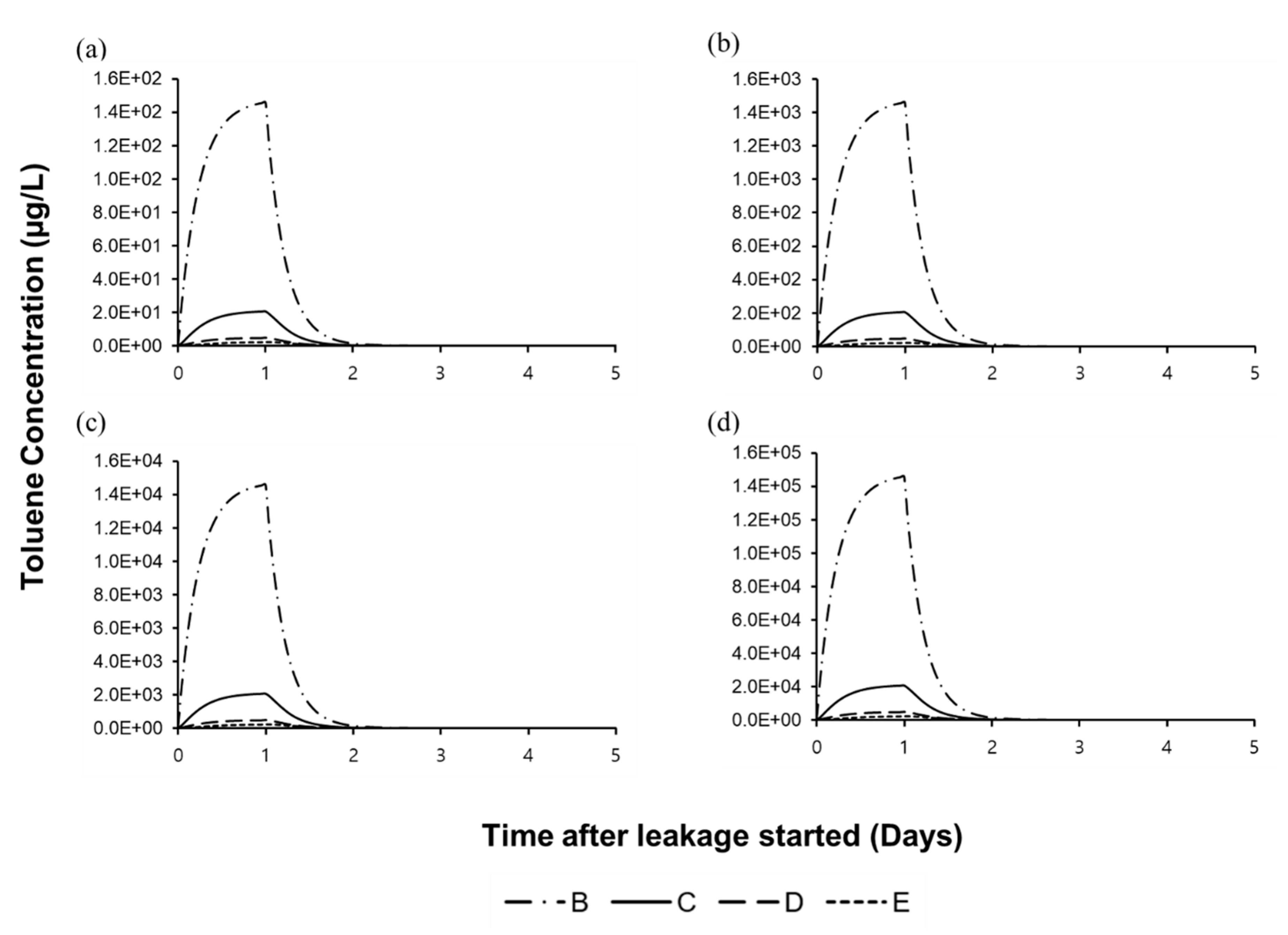
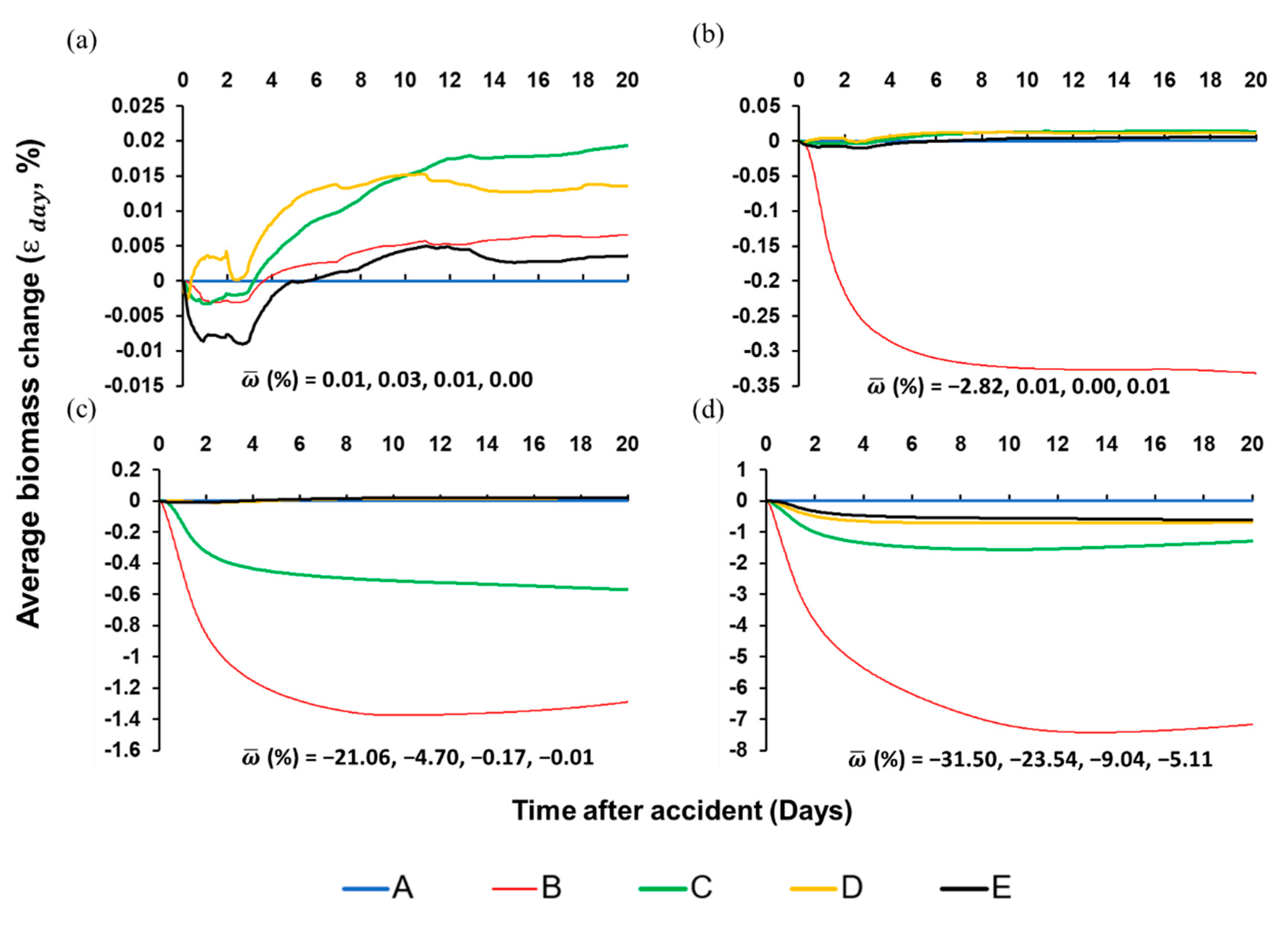
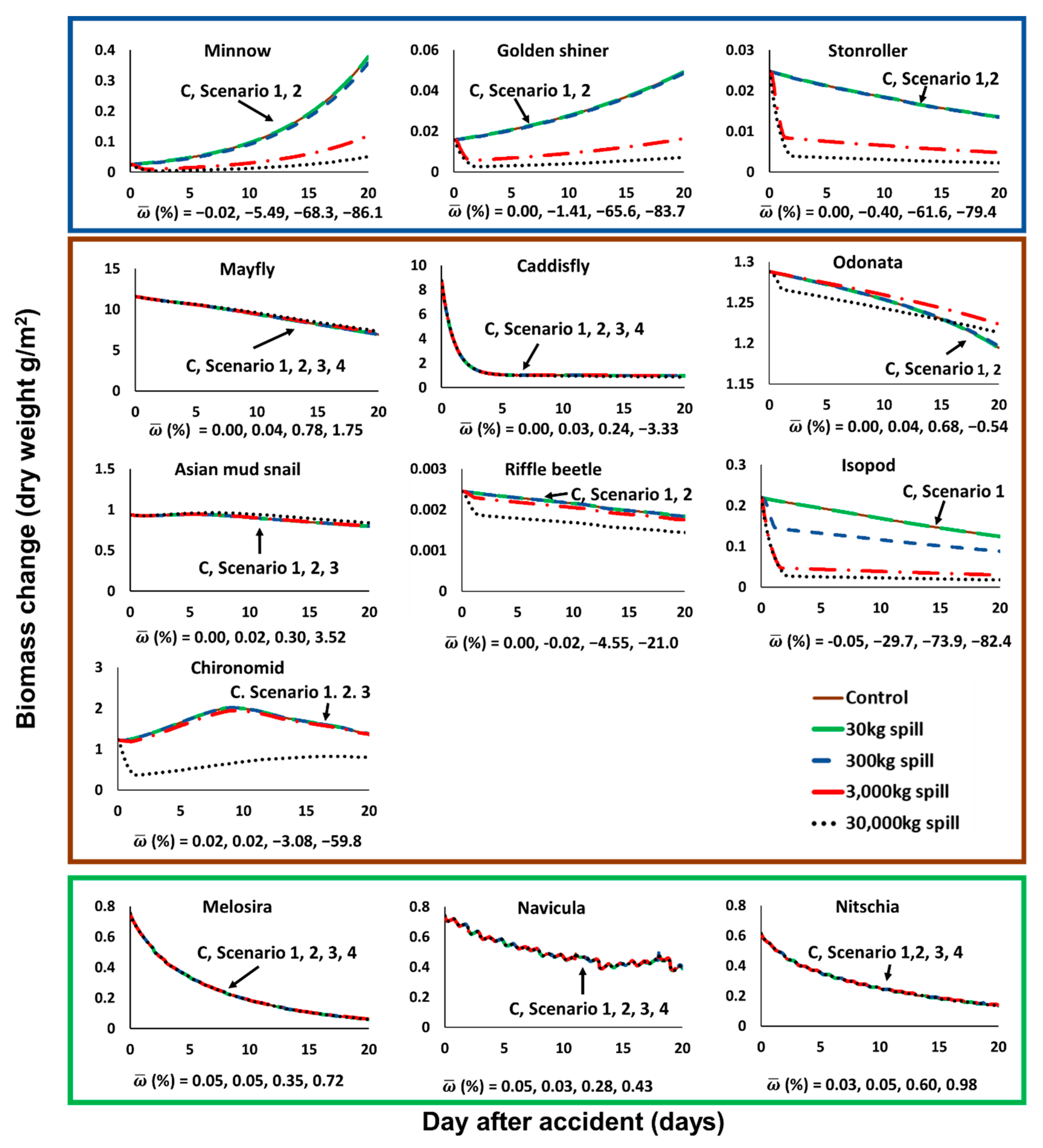
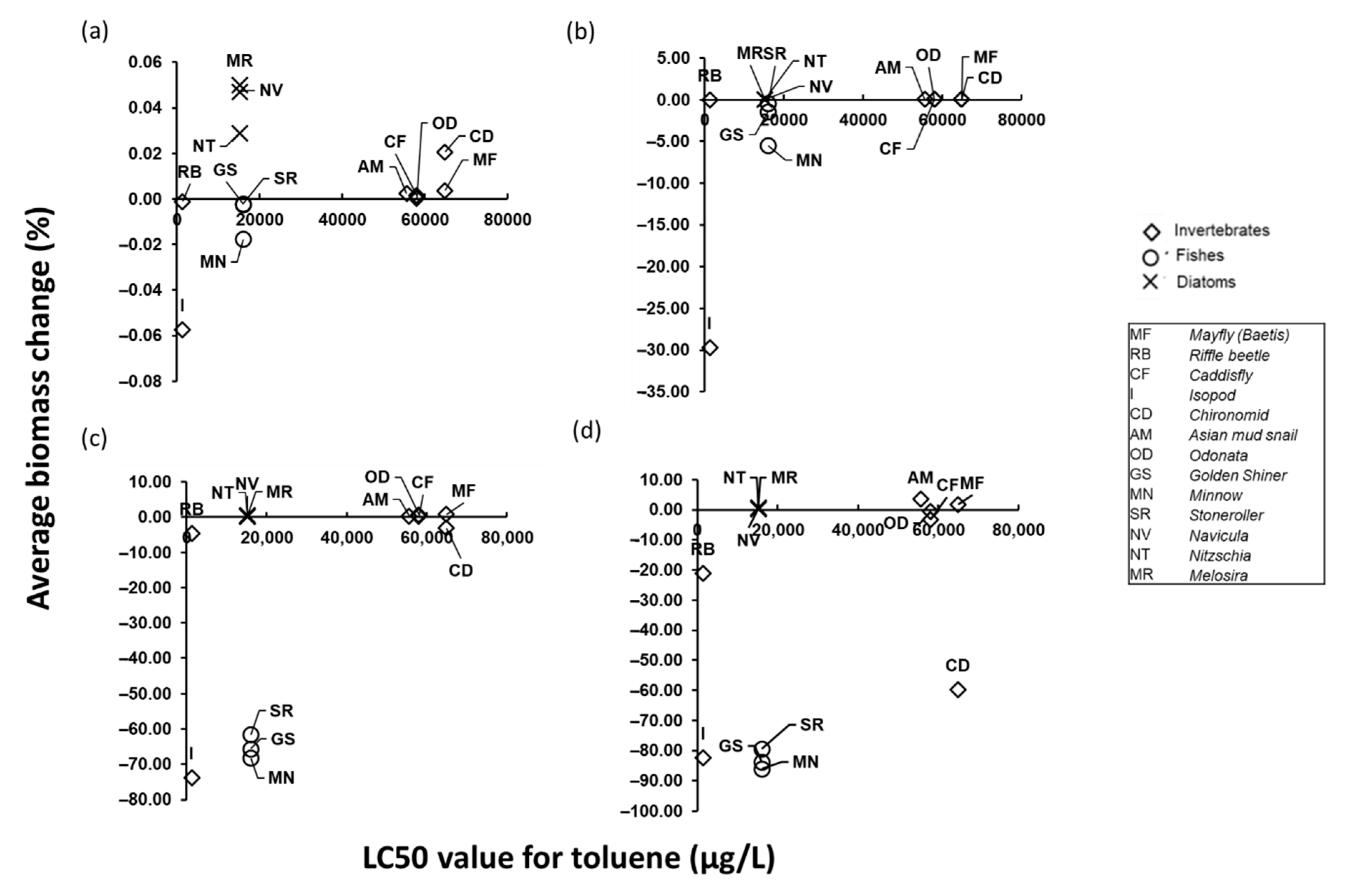
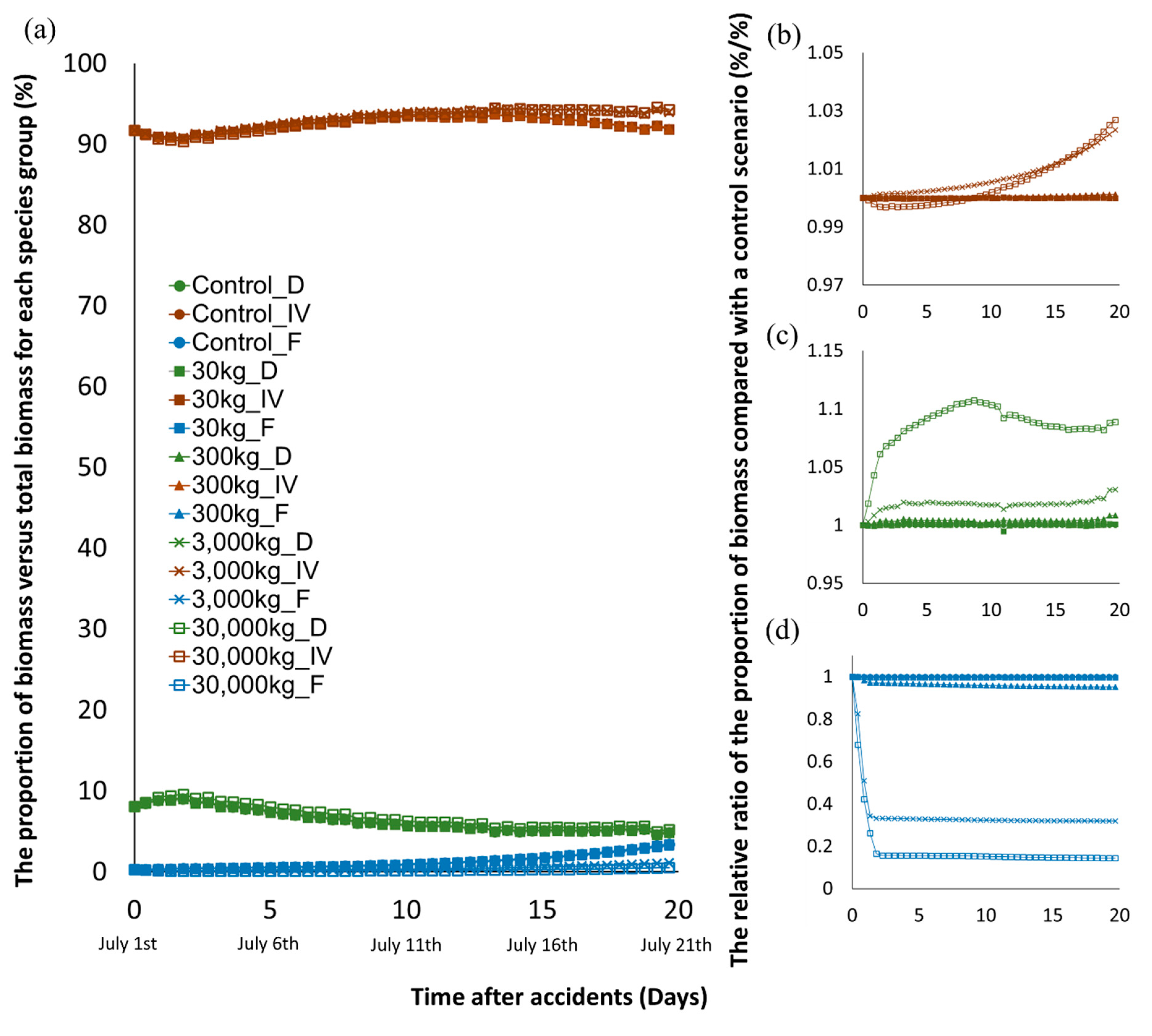
Publisher’s Note: MDPI stays neutral with regard to jurisdictional claims in published maps and institutional affiliations. |
© 2020 by the authors. Licensee MDPI, Basel, Switzerland. This article is an open access article distributed under the terms and conditions of the Creative Commons Attribution (CC BY) license (http://creativecommons.org/licenses/by/4.0/).
Share and Cite
Yeom, J.; Kim, I.; Kim, M.; Cho, K.; Kim, S.D. Coupling of the AQUATOX and EFDC Models for Ecological Impact Assessment of Chemical Spill Scenarios in the Jeonju River, Korea. Biology 2020, 9, 340. https://doi.org/10.3390/biology9100340
Yeom J, Kim I, Kim M, Cho K, Kim SD. Coupling of the AQUATOX and EFDC Models for Ecological Impact Assessment of Chemical Spill Scenarios in the Jeonju River, Korea. Biology. 2020; 9(10):340. https://doi.org/10.3390/biology9100340
Chicago/Turabian StyleYeom, Jaehoon, Injeong Kim, Minjeong Kim, Kyunghwa Cho, and Sang Don Kim. 2020. "Coupling of the AQUATOX and EFDC Models for Ecological Impact Assessment of Chemical Spill Scenarios in the Jeonju River, Korea" Biology 9, no. 10: 340. https://doi.org/10.3390/biology9100340
APA StyleYeom, J., Kim, I., Kim, M., Cho, K., & Kim, S. D. (2020). Coupling of the AQUATOX and EFDC Models for Ecological Impact Assessment of Chemical Spill Scenarios in the Jeonju River, Korea. Biology, 9(10), 340. https://doi.org/10.3390/biology9100340




